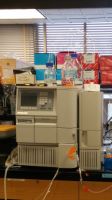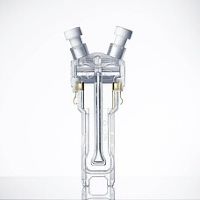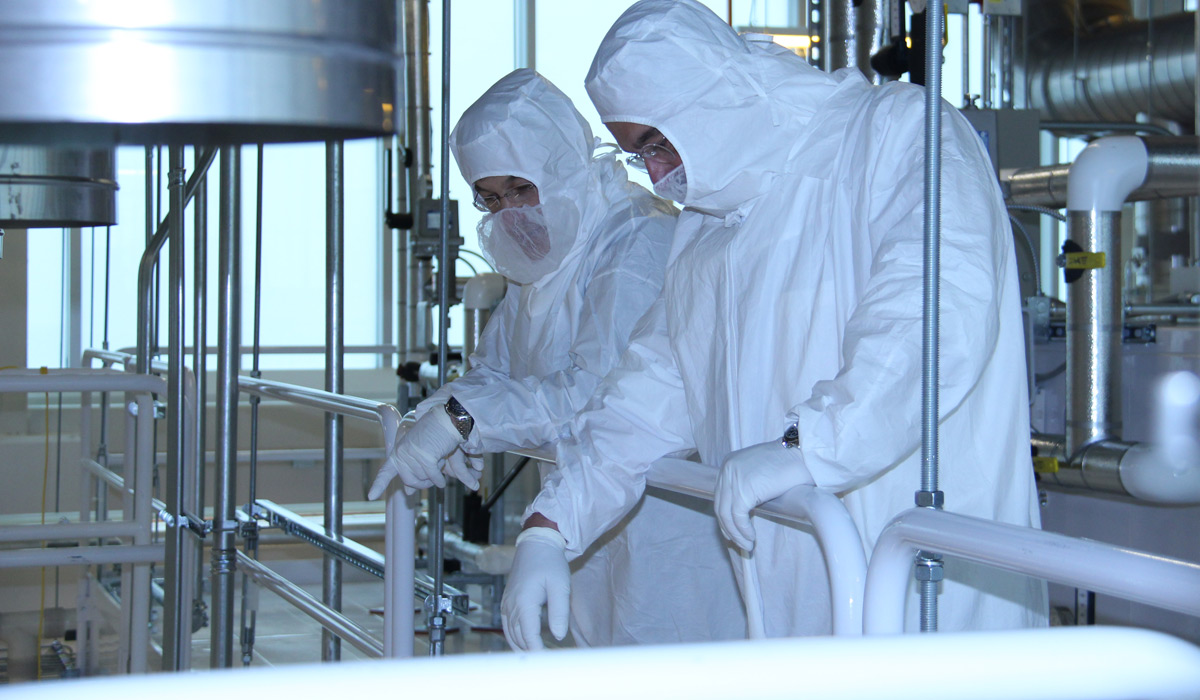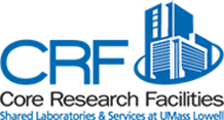Materials & Chemical Characterization Lab: 19 Resources found
 | Dynamic Light Scattering Instrument 2 Documents AvailableHoriba SZ-100 Location: Olney OG-4
Training estimate: 4 hours
Horiba SZ-100 for particle size and zeta potential measurements.
· 0.3 nm to 8 µm sizes
· Particle size measurements at both 90° and 173°
· 0°C to 60°C
· Recommend 1 ml volumes and to bring blanks
· For zeta potential, -200 to +200mV
Must provide own cuvette cells and zeta potential cells. We sell zeta potentials cells, if you prefer to purchase from the CRF.
| Industry Rates
|
 | Dynamic Light Scattering Instrument Anton Paar Litesizer 701 The Litesizer DLS 701 is an advanced, user-friendly dynamic light scattering (DLS) instrument designed for high-precision analysis of particles in suspension. It provides essential data for characterizing particle size, zeta potential, and molecular mass, making it ideal for applications across pharmaceuticals, nanomaterials, polymers, and biotechnology. With intuitive software, automatic angle selection, and real-time monitoring, it supports expert research.
Key Features
· Particle size range: 0.3 nm to 12 µm with high resolution
· Zeta potential range: 1.3 nm to 100 µm using patented cmPALS technology
· Multi-Angle Particle Sizing (MAPS): Three-angle measurement (15°, 90°, 175°)
· Real-time transmittance monitoring: Detects sedimentation or agglomeration
· Built-in refractive index measurement: No need for external lookup tables
· Automated angle selection: Reduces user error and simplifies operation
· User interface: Kalliope software with intuitive 3-click measurement setup
| Industry Rates
|
 | Fluorescence Spectrophotometer Hitachi F-2500 The Hitachi F-2500 Fluorescence Spectrophotometer is a high-sensitivity analytical instrument designed for qualitative and quantitative fluorescence analysis. It supports a wide range of applications in life sciences, biotechnology, materials research, quality control, and education. This system combines Hitachi’s advanced optical technology with modern, intuitive software for high-precision and user-friendly operation.
Key features include a signal-to-noise ratio of up to 800 (RMS), multi-step slit widths (2.5–20 nm), and versatile wavelength scan speeds. The F-2500 is equipped with powerful data handling capabilities including Excel-compatible data export and a print preview function. Operation is facilitated through a mouse-controlled, icon-based interface.
The system uses a 150 W xenon lamp as its light source and offers a wavelength range of 220–730 nm. It is capable of monitoring samples as small as 0.6 mL in a standard 10 mm cuvette and delivers resolution down to 2.5 nm.
| Industry Rates
|
 | Fourier-Transform Infrared Spectrometer (FT-IR) 1 Document AvailableThermo Fisher Scientific Nicolet iS50
· Built-in ATR
· Automated KBr beamsplitter exchanger
· DLaTGS-KBr detector
· 4000 cm-1 to 400 cm-1
· Touch point operation for optics and data collection
· Several FT-IR libraries
· Omnic software for experiments and reporting
Located in Olney G12
| Industry Rates
|
 | Gas Chromatograph Mass Selective Detector 1 Document AvailableAgilent Technologies Agilent Single Quadrupole Gas Chromatograph Mass Selective detector ( GC/MS).
Agilent 7890A GC with Agilent MSD 5975 MS using MassHunter software. A GC is used to separate low molecular weight chemicals using helium as a carrier gas. Constituents are separated at different rates based on their various chemical and physical properties as well as their interaction with the column stationary phase. As chemicals exit the column, they are identified using the Mass Spectrum. The stationary phase helps separate components using gas flow rate, column length and temperature.
Located in Olney G-12
| Industry Rates
|
 | Gel Permeation (GPC) 2 Documents AvailableWaters Alliance 2695 Gel Permeation Chromatography (GPC)
Located in Olney G-12
THF ONLY BASED SYSTEM
Gel Permeation Chromatography (GPC) also referred to as Size Exclusion Chromatography (SEC) is a powerful and versatile analytical technique for understanding and predicting polymer performance. It is a mode of liquid chromatography which separates components of a mixture based on size. In GPC/SEC, larger molecules elute from the column first, and smaller molecules elute later. This technique is used for understanding and predicting polymer performance. It is the most convenient technique for characterizing the complete weight distribution of a polymer.
GPC can determine several important parameters:
o Number average molecular weight
o Weight average molecular weight
o Molecular weight distribution
o polydisperity
GPC is performed on a Waters Alliance 2695 HPLC system with PDA detector and refractive index detector. We use Waters Styragel HR columns 1,3, and 4 for molecular weight determination of up to 600K. This system is run using 100% tetrahydrofuran(THF only) as the mobile phase at a flow rate of 0.9ml/min. Each sample must be dissolved in 100% tetrahydrofuran for 24 hours before analysis at 10 to 20 mg/ml, and filtered through a 0.45 micron nylon or PTFE filter. Polystyrene standards from a molecular weight of 500 to 400K are used to create the calibration curve. Each GPC run takes one hour to complete. There is a 105 sample carousel for automatic injections. Empower 2 is the software system for controlling the separation and analysis.
Training takes approximately one to two hours. Please contact wendy_gavin@uml.edu for any questions, training or service | Industry Rates
|
 | High Performance Liquid Chromatography 2 Documents AvailableAgilent 1100 Located in Olney G-12
HPLC is one of the most powerful tools in analytical chemistry. It has the ability to separate, identify, and quantitate the compounds that are present in any sample that can be dissolved in a liquid. HPLC could be used to understand the elemental composition of a drug substance, chemical substance, or food product.
The CRF offers a C18 Reverse Phase column with acetonitrile, methanol, and water as mobile phases. Triflouroacetic acid is offered as a mobile phase additive. Qualitative and Quantitative analysis is possible.
We offer an Agilent 1100 HPLC system equipped with auto-sampler and PDA detector. Up to 5 different wavelengths can be analyzed at the same time. Chemstation software controls the HPLC experiments and data anaylsis.
Training takes 2 to 4 hours depending on type of analysis, experience, and method development. We offer training to become self-users as well as service options. Please contact wendy_gavin@uml.edu for questions, training or service. | Industry Rates
|
 | High Performance Liquid Chromatography Waters Alliance 2695 Located in Olney G-12
We offer a Waters Alliance 2695 HPLC system equipped with a Waters 2996 photodiode array detector, and Waters 410 refractive index detector. Empower 3 software is used to analyze sample data and purity. It contains a quaternary pump, auto sampler and column oven.
Training takes 2 to 4 hours depending on type of analysis, experience, and method development. We offer training to become self-users as well as service options. Please contact wendy_gavin@uml.edu for questions, training or service.
| Industry Rates
|
 | Inductively Coupled Plasma - Mass Spectrometer 1 Document AvailableAgilent 7900 Located in Olney G-3
Training requirements: 4 hours
Agilent 7900 ICP-MS is a single quadrupole mass spec instrument.
· Helium (He) cell gas mode improves accuracy by providing reliable control of polyatomic interferences
· Off-axis lens provides high sensitivity and low detection limits across the mass range
· Wide dynamic range detector allows you to measure majors and trace in one run
· Fast integration (0.1 ms dwell time) supports analysis of fast transient signals such as single nanoparticles (spICP-MS)
· ICP-MS MassHunter Method Wizard builds your methods automatically
· ppb to ppt range
· SPS 4 Auto sampler
User must provide own conical tubes and standards
Highly recommended to provide blank dilution solvent
| Industry Rates
|
 | Inductively Coupled Plasma - Optical Emission Spectrometer 1 Document AvailableAgilent 5110 Located in Olney G-3
Training requirements: 4 hours
Agilent 5110 ICP-OES
· dichroic spectral combiner (DSC) that enables synchronous radial and axial measurements
· Measure your toughest samples with a vertical torch
· Measure your toughest samples with a vertical torch
· Measure all wavelengths in one measurement
· Agilent ICP Expert Software
· Charge coupled Detector
· ppm to ppb range
· SPS 4 Auto sampler
User must provide own conical tubes and standards
Highly recommended to provide blank dilution solvent
| Industry Rates
|
 | Liquid Chromatograph Mass Spectrometer (LC/MS) 4 Documents AvailableShimadzu 8040 Located in Olney G-12
The Shimadzu 8040 Triple Quadrupole LC/MS is an analytical system that combines the separating power of liquid chromatography with the qualitative and quantitative power of mass spectrometry. Mass spectrometry detectors offer information including molecular weight, structural information, purity, quantity, and identity of sample. The LC/MS can analyze samples from small molecule to large proteins and peptides. It can measure a m/z ratio of up to 2000.
Ionization modes include electrospray interface (ESI) and dual ion source (DUIS). Duis enables ESI, APCI, positive and negative ionization in the same analysis, significantly improving efficiency by simultaneously analyzing a wide variety of compounds in a single run.
Data Acquisition modes offered are:
· SCAN
· SIM-selected ion monitoring
· Multiple Reaction Monitoring (MRM)
· product ion scan
· precursor ion scan
· neutral loss scan modes.
Scanning in positive and negative modes occurs simultaneously. Using LabSolutions software, the LC/MS offers automation, method optimization, and data analysis techniques.
The CRF offers training to become independent users or services to run samples for our customers. We offer a C18 RP column along with acetonitrile, methanol, and water for mobile phases. Users are required to supply their own columns, HPLC methods, mobile phase additives, and a properly prepared sample. All mobile phases, columns, and samples must be approved for use in LC/MS before any analysis. Training requires 1 to 4 hours before self use. The scheduling of samples, training, and services must be approved by contacting Wendy Gavin at wendy_gavin@uml.edu prior to signing up for a reservation on the CRF website. | Industry Rates
|
| MCC Technical Assistance | Industry Rates
|
 | Microwave Digestion System Milestone Ethos Easy Ethos Easy is an advanced microwave-assisted closed-vessel acid digestion system for the preparation of various materials for trace elemental analysis using ICP-OES or ICP-MS.
Training requirements: 4 hours
| Industry Rates
|
 | Quadrupole Time-of-Flight Mass Spectrometer (Q-TOF) Waters Xevo G2-XS Located in Olney G-12
Tandem quadrupole mass spectrometer with Acquity UPLC and TUV detector for separation of complex mixtures of small molecules to large molecules. The Xevo G2-XS Qtof combines StepWave ion optics for robust sensitivity with the XS collision cell to achieve low levels of sensitivity with accurate mass detection. More information can be obtained for more complex studies providing high quality data.
· TUV detector
· Used to identify, quantify, and confirm compounds
· MSE is a simple but powerful approach to deliver
accurate mass precursor and fragment ion data
· m/z up to 8000
· ESI ionization
| Industry Rates
|
 | Surface Area and Porosimetry System Micromeritics ASAP2020 Plus Automatic Micropore and Chemisorption Analyzer Training requirements: 4-8 hours depending on the required analysis
b. High-performance sorption analyzer producing research grade analytical measurements for the determination of active metal surface area and dispersion by chemical adsorption and specific surface area and pore size distribution from 3.5 to 5000 Ångstroms by physical adsorption.
c. Independent vacuum systems for sample degassing (two ports) and analysis (one port)
d. Physisorption reports include isotherm, BET surface area, Langmuir surface area, t-Plot, Alpha-S Method, BJH Adsorption and Desorption, Dollimore-Heal Adsorption and Desorption, Temkin and Freundlich, Horvath-Kawazoe, MP-Method, DFT Pore Size and Surface Energy, and Dubinin-Astakhov
e. Chemisorption data reports include active metal surface area, average crystallite size, irreversible and reversible sorption, monolayer capacity, and active metal dispersion
f. Available gases include nitrogen, helium, argon, hydrogen, and carbon monoxide.
User must provide their own sample tube purchased from Micromeritics. Part number 240/61003/00. Tube, Sample, ½ inch diameter.
| Industry Rates
|
 | Viscometer Brookfield DV-III The Brookfield DV-III Ultra Programmable Rheometer, paired with its base unit and the TC-500 Circulating Bath, is designed to accurately measure fluid shear stress and viscosity across a range of shear rates. This advanced viscometer delivers precise and consistent viscosity data, making it ideal for a wide array of applications. Featuring programmable rotational speeds from 0.01 to 250 rpm, it ensures highly repeatable results. With an intuitive, user-friendly interface, the DV-III supports efficient and dependable viscosity analysis. It is an essential instrument for laboratories and industries that demand high-precision viscosity measurements for both quality assurance and research and development purposes.
| Industry Rates
|
 | X-ray Diffractometer 1 Document AvailableRigaku SmartLab X-Ray Diffractometer
NOTE: FOR NON-STANDARD POWDER DIFFRACTION ANALYSIS, PLEASE RESERVE 15 MINS OF “LAB STAFF ADDITIONAL COSTS” IN ADDITION TO YOUR “X-RAY DIFFRACTOMETER” RESERVATION.
a. Training requirements: 6-8 hours depending on the required analytical techniques
b. Multipurpose and high resolution theta-theta x-ray diffraction system
c. 3 kW highly stable (0.01% stability) and reliable sealed ceramic tube x-ray generator with focal spot of 0.4mm x 12.0mm
d. Incident Cross Beam Optics (CBO) with parabolic mirror and user selectable Parallel Beam (PB) and Bragg-Brentano (BB) optical configurations for asymmetric and symmetric geometries. A Ge(220) 2-bounce incident beam monochromator is available for high resolution PB measurements of crystal structure of imperfect crystals.
e. High-resolution vertical theta-theta goniometer for horizontal specimen mounting and measurement. Stage accessories include standard powder, bulk and thin film holders; 6-position automatic sample changer; airtight sample holder for air-sensitive samples; Eulerian cradle for sample tilt, rotation and z-axis motion; and an Anton-Paar TTK600 temperature-controlled (-20 degC to 600 degC) chamber with inert gas, air, or vacuum environment.
f. Parallel beam small-angle x-ray scattering (SAXS) attachment available with transmission and reflection stage geometries for pore and particle size distribution analysis, measurement of long periodicities, and nanoparticle modelling.
g. 2D Grazing Incidence SAXS/WAXS attachment available in reflection mode for thin film analysis
h. Diffracted beam optics assembly include parallel slit analyzers, Ge analyzer, K-beta filters and dual receiving slits
i. HyPix3000 Hybrid Pixel Array 0D/1D/2D Detector with an optional vertical mount to extend 2-theta coverage to 14.7 deg 2-theta acceptance angle.
j. SmartLab Studio II features include XRD Measurement plugin, Data Manager plugin, SmartLab Guidance, Powder Basic and Comprehensive Analysis plugins, Powder Rietveld/WPPF Analysis plugin, X-Ray Reflectivity plugin, HR-XRD Analysis plugin, Texture Basic plugin, Materials Research SAXS Analysis software, and Data Visualization plugin. Crystallography Open Database (COD) also included.
| Industry Rates
|
 | Zeta Potential Disposable Cuvette Zeta Potential Measurement disposable cell, 100 µl, aqueous only
| Industry Rates
|
 | Zeta Potential Omega Cuvette | Industry Rates
|


